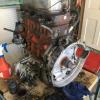I hope you can help me. Am having a great time building up my engine using AndyMiniMad's guide ( http://www.theminifo...building/page-2 )
- I have just put in my camshaft and have timed it dot-to-dot. It's a Minispares Evolution 001 so it is a bit spicy in comparison to a standard 1275 cam.
I wanted to make sure the timing is as accurate as I can get so I am following his DTI timing teachings. All has gone well up until the point I get to maximum lift on No1 inlet pushrod. He says to turn the crank backwards after zeroing the DTI at max lift until it reads 0.025" (a pretty small amount) but does this mean -0.025" from zero? It's not entirely clear. He then says to move the crank forwards again to 0.005". Trouble is I can't get a reading at all past 0 when I turn the crank forwards. Should it be 0.005" less than -0.025" (so -0.020") or am I just doing something ridiculous thick here and just not getting it? And where do the 0.025" & 0.005" figures come from? I am confused and am convinced I am doing something wrong...
I reckon my engine will be "ok" at dot to dot but I would like to be sure. I have e-mailed Andy but he hasn't been on the forum since January so any help gratefully received ![]()




















